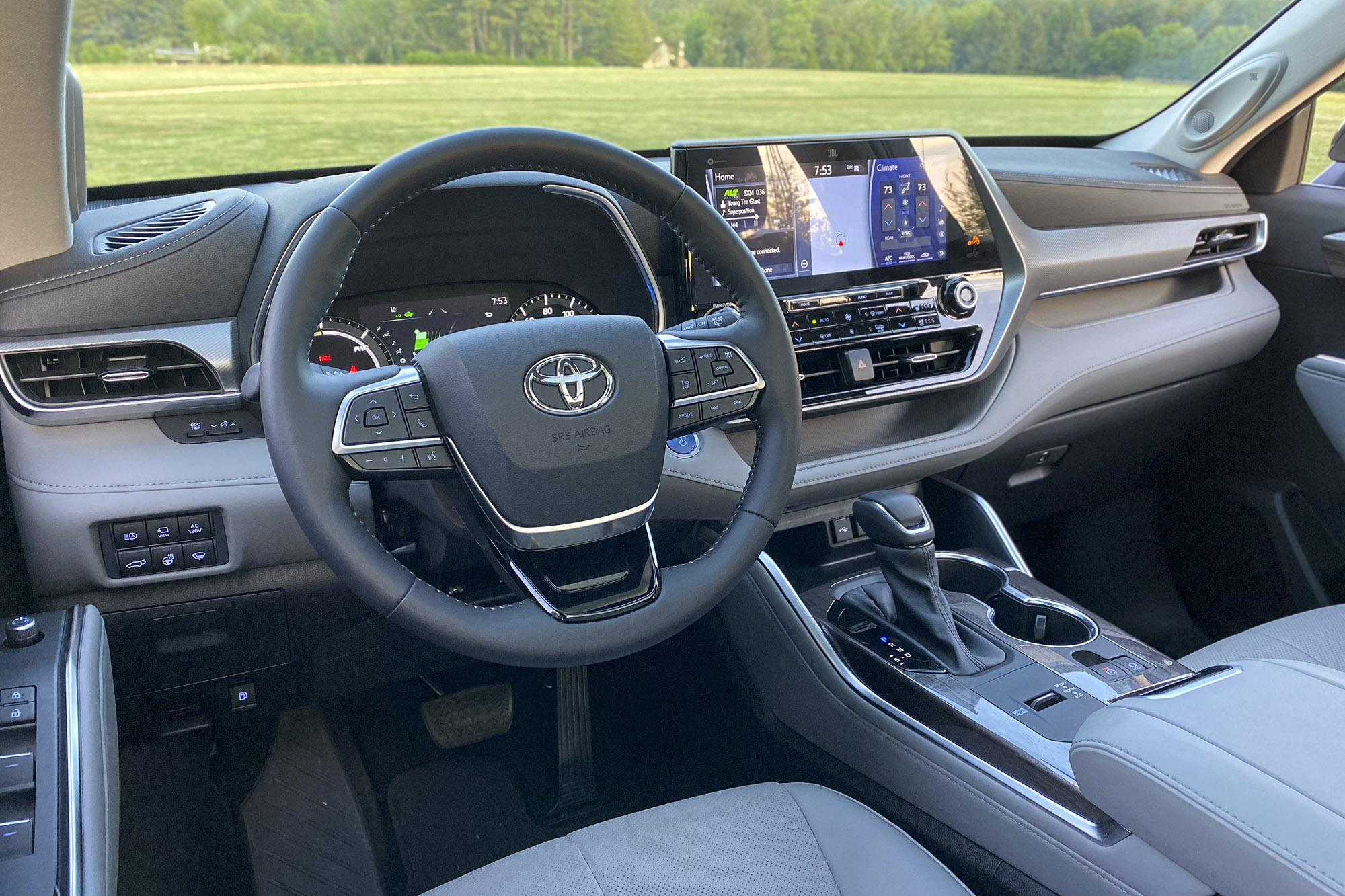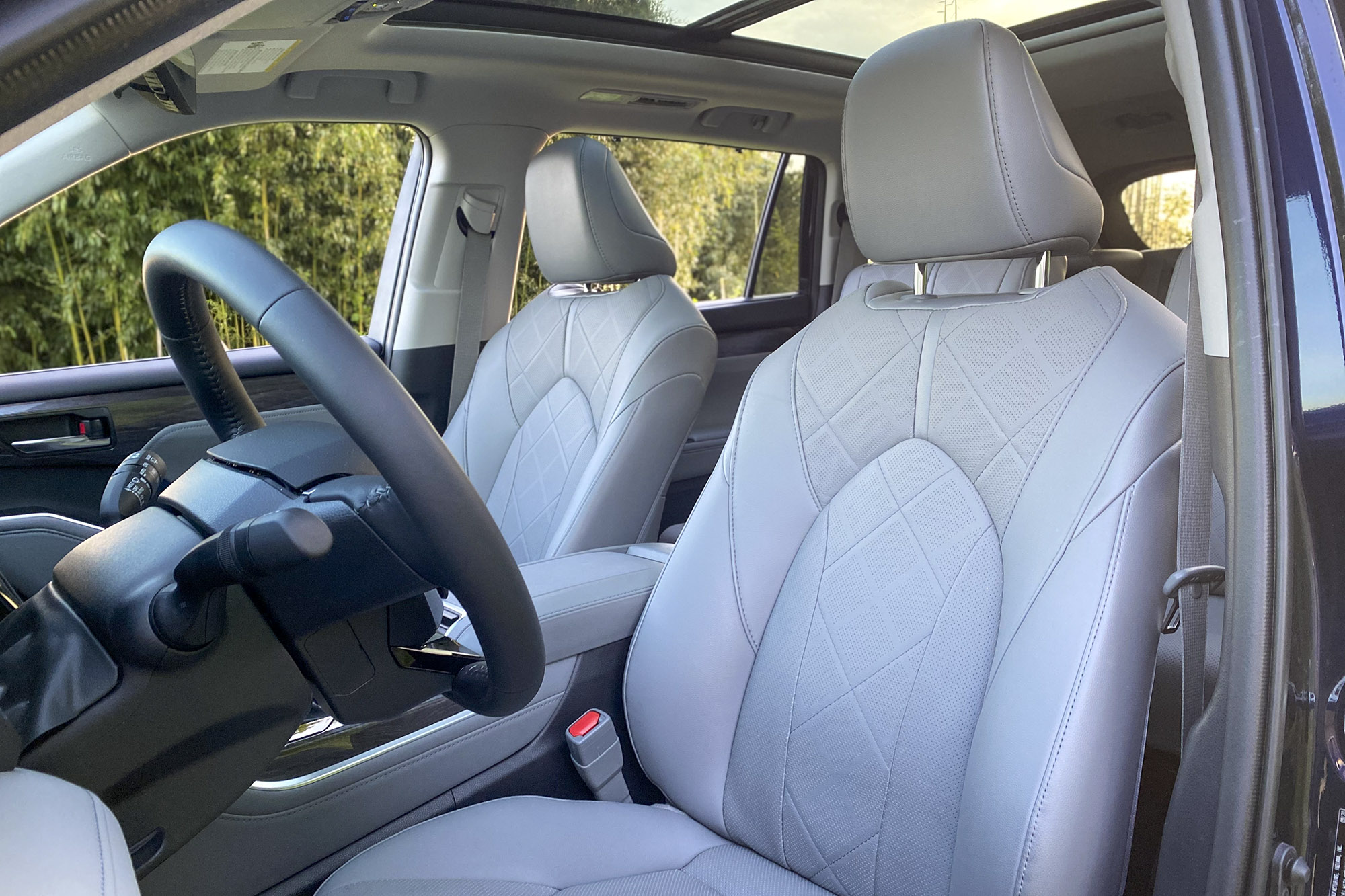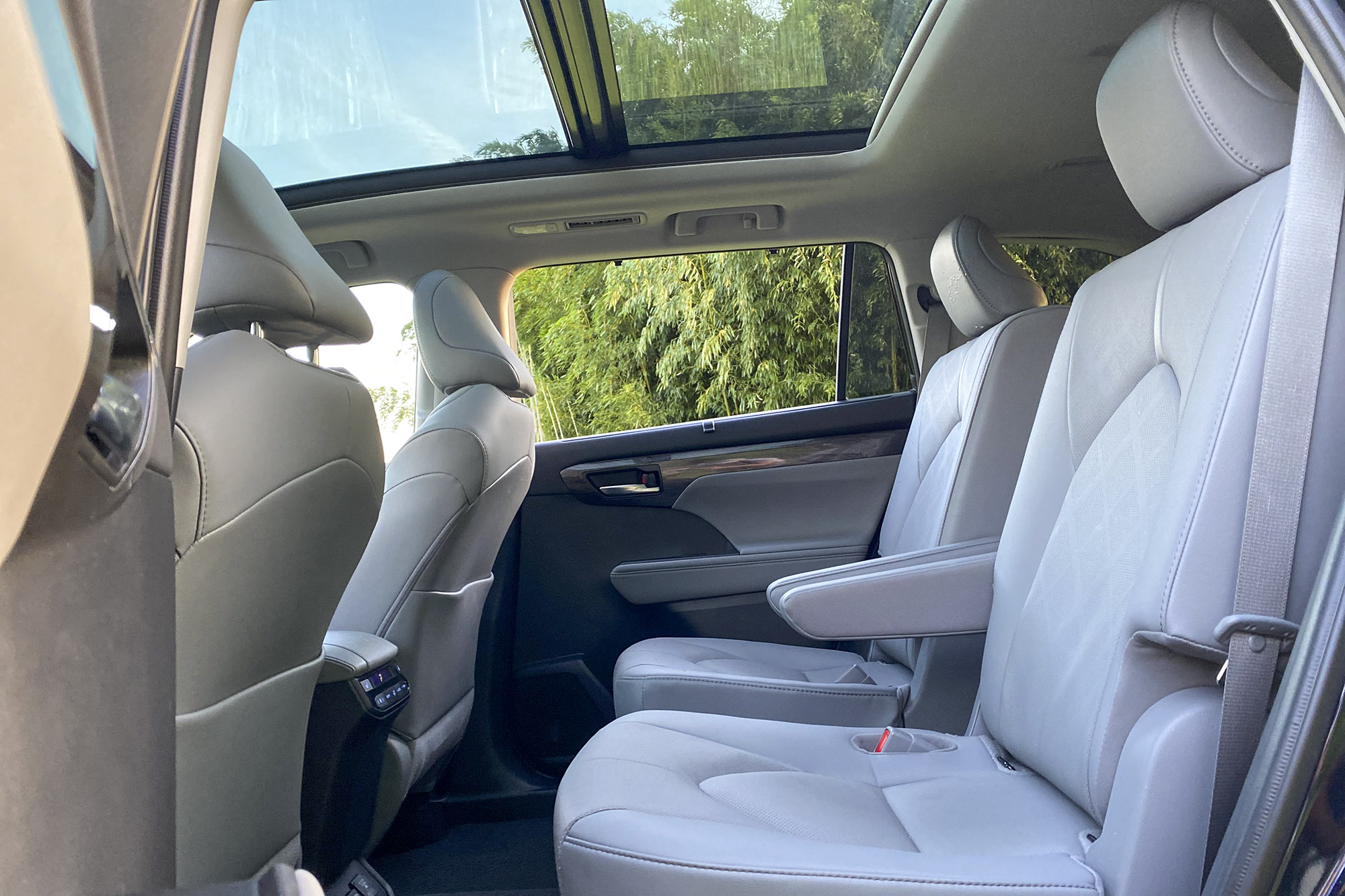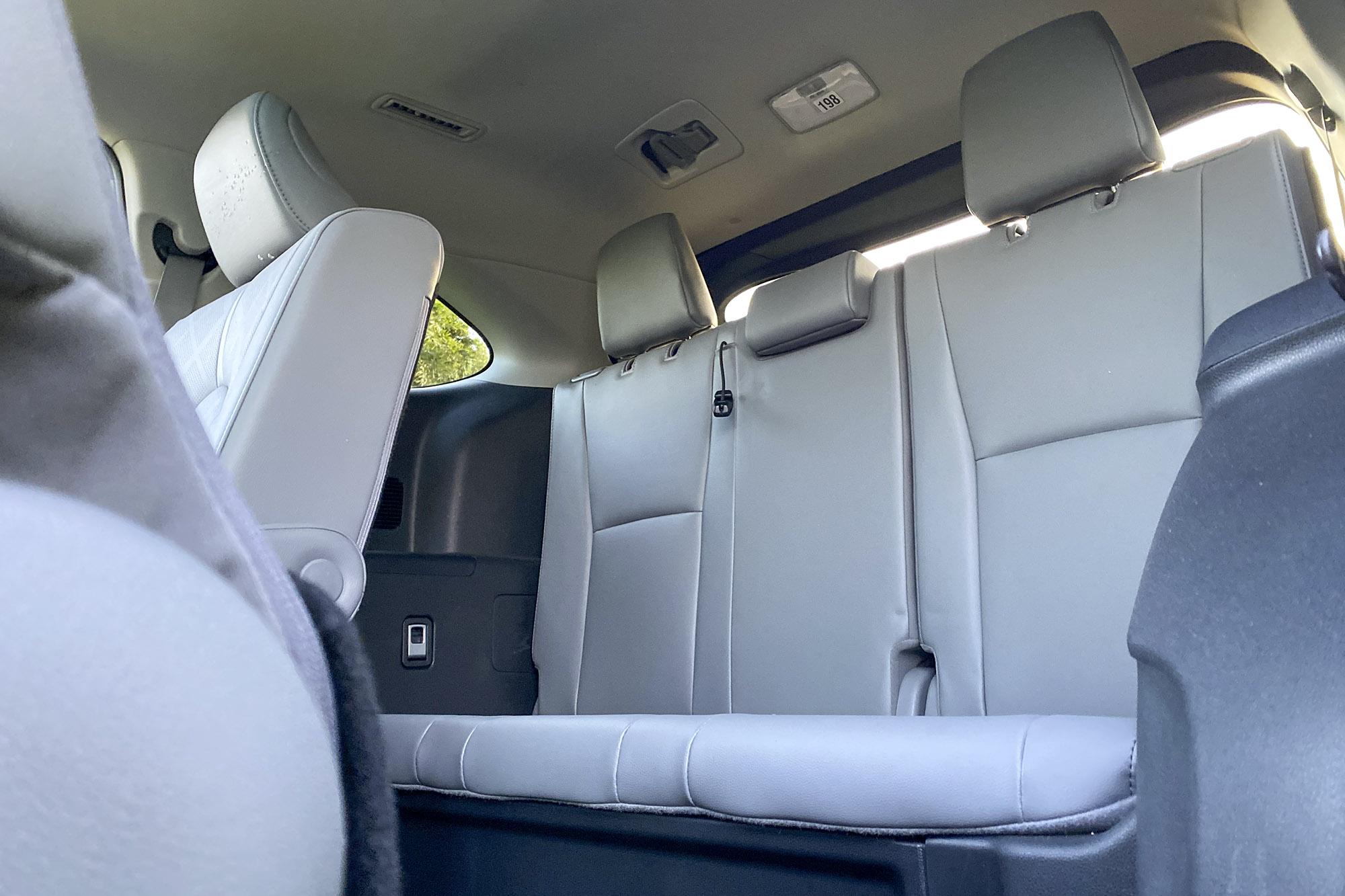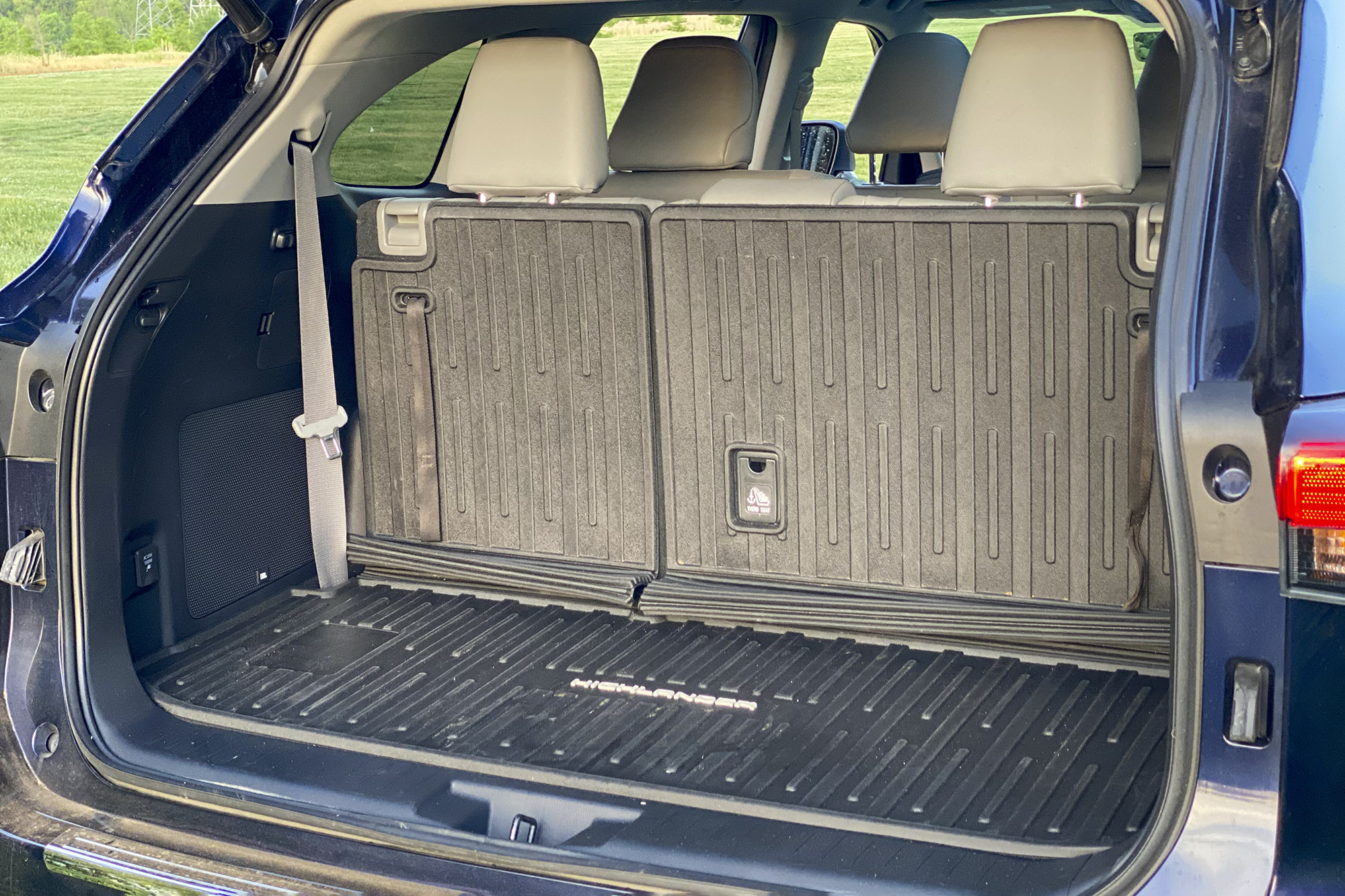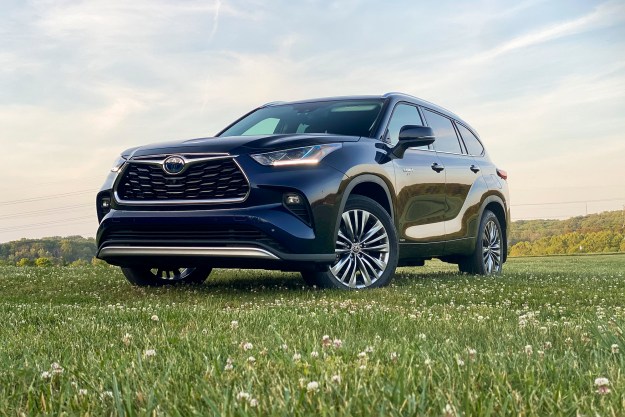
- Up to 36 mpg combined
- Available all-wheel drive
- Refined ride
- Safety galore
- Helpful tech
- Cramped third row
- Below-average cargo space
When you have plenty to haul, but can’t stomach a minivan, three-row SUVs have become the go-to option. You’ll make a number of compromises by choosing to go with a midsize SUV over a minivan, but the 2021 Toyota Highlander Hybrid proves that fuel economy doesn’t have to be one of them.
While the Highlander struggles to compete in the massive lake that is the midsize SUV segment, the electrified Highlander Hybrid swims in a much smaller pond. Its only real competitors include the Kia Sorento Hybrid and Ford Explorer Hybrid. But it doesn’t just excel because of a lack of competition: The Highlander Hybrid’s main claim to fame is that it offers compact car levels of fuel economy in a package that can seat up to eight and is more attractive than a minivan.
Pricing for the 2021 Toyota Highlander starts at $39,950 with the mandatory $1,215 destination fee. That amount will get you into the LE trim with front-wheel drive. Our test vehicle was a range-topping Platinum trim with all-wheel drive. The Platinum starts at $49,905, while all-wheel drive bumps the as-tested price up to $51,855.
Design and interior
Toyota’s RAV4, Venza, and Highlander not only share Toyota’s New Global Architecture (TNGA) platform, they share a harmonious design language that makes it easy to tell that they’re all siblings. Despite being the largest SUV of the trio, the Highlander Hybrid is the most stoic of the bunch. It forgoes the blocky exterior design of many other midsize SUVs in favor of something with flowing lines. Even the front grille, which tends to be one of Toyota’s most controversial design elements, is subdued and cohesive on the Highlander Hybrid.

The thing with boxy designs is that they maximize interior space. The Highlander Hybrid’s interior design doesn’t. The third row offers just 27.7 inches of legroom, which makes it a tight squeeze for everyone, including children. It’s one of the lowest figures in the midsize class. Cargo capacity is a similar story, as the Highlander Hybrid offers 16 cubic feet of cargo space behind the third row and a total of 84.3 cubic feet of space behind the first row. You’ll find more space in non-hybrid options like the Volkswagen Atlas and Chevrolet Traverse, though Toyota at least bests the Hyundai Sorento Hybrid’s pitiful 75.5 cubic feet of total cargo space.
The things that really matter, like seat comfort and visibility, are notably good.
Despite its asymmetrical interior design and odd mix of sharp edges, Toyota has integrated a few useful storage areas inside. For the most part, material quality in our test vehicle felt good for a $51,000 SUV except for a few glaring things: The silver trim on the dash and the faux wood located throughout the cabin. Beyond clashing against one another, the silver trim on the dash is scraggly to the touch and feels like it’s from a bargain-basement value option.
The things that really matter, like seat comfort and visibility, are notably good. The front bucket seats provide all-day levels of comfort and the available second-row captain’s chairs aren’t that far off in comfort, either. Thanks to the hybrid powertrain, the Highlander Hybrid’s remains quiet in most circumstances. Plus, Toyota fits the Platinum trim with acoustic noise-reducing windows that further help with the SUV’s hushed cabin. Our Highlander Hybrid Platinum test vehicle came fitted with niceties that included a digital rearview mirror, heated and ventilated front seats, leather upholstery, a panoramic moonroof, and heated second-row captain’s chairs.
Tech, infotainment, and driver assist
You’ll find the same infotainment system in the Highlander Hybrid as in many other Toyotas. The standard unit is an 8-inch touchscreen that includes Apple CarPlay, Android Auto, Amazon Alexa, five USB ports, a built-in Wi-Fi hot spot, Bluetooth, and six audio speakers. Our test vehicle came with a larger 12.3-inch touchscreen, navigation, an 11-speaker JBL audio system, a wireless charger, and a head-up display.
Being able to split three functions on the screen is a nifty feature and makes the best use of the 12.3-inch screen’s real estate.

As frustrating as they may be, automakers are moving toward buttonless infotainment systems and touchscreens that have a portrait orientation. These may be in for 2021, but it’s refreshing to see Toyota avoid both of these trends. Most of the controls, except for the tuning function for the radio, are well within reach for the driver. Being able to split three functions on the screen is a nifty feature and makes the best use of the 12.3-inch screen’s real estate. The main issue with Toyota’s infotainment system is that it features outdated graphics that feel like it’s from the original Motorola Razr generation of technology. The layout of the menus isn’t intuitive, either.
Every Highlander Hybrid comes with the Toyota Safety Sense 2.5+ suite of advanced safety features. The suite includes all sorts of goodies, including forward collision warning, pedestrian detection, adaptive cruise control, Toyota’s Lane Tracing Assist, automatic high beams, lane-keeping assist, and traffic sign recognition.
Our tester offered a 360-degree bird’s eye view when reverse is engaged, which proved helpful despite the low resolution. A digital rearview mirror is also incredibly useful when all three rows are in use. The quality of the image severely decreases at night, but one flick of a switch returns it to being a traditional mirror.
Driving experience

Under the hood, Toyota’s familiar 2.5-liter four-cylinder engine paired with two electric motors delivers a combined output of 243 horsepower. If that sounds familiar, that’s because it’s the same powertrain found in the RAV4 Hybrid. A continuously variable automatic transmission (CVT) handles shifts and routes power through the front wheels as standard, or all-wheel drive on up-optioned models like our tester.
The hybrid powertrain isn’t too far off the gasoline model’s 3.5-liter V6 engine that’s rated at 295 horsepower and is in the middle of its rivals. The Sorento Hybrid has a smaller four-cylinder engine and one electric motor for up to 227 horsepower, while the Explorer Hybrid comes with a 3.3-liter V6 and an electric motor for 318 horsepower. The Highlander Hybrid also finds itself sandwiched in the middle with a towing capacity of up to 3,500 pounds — the Sorento Hybrid is rated at 2,000 pounds and the Explorer Hybrid can tow 5,000 pounds.
Neither Hybrids nor midsize SUVs are known for being athletic, so it should come as little surprise that the Highlander Hybrid is not. The electrified hybrid has plenty of power for city use and running around town, but can feel underpowered when passing on the highway. When digging into the throttle pedal to complete a pass, the four-cylinder engine shrieks to life with an awful thrum. Most drivers will want more performance from the Highlander Hybrid, as it’s far from an exciting SUV, but it’s certainly enough to get the job done. Toyota certainly knows how to make hybrids and it shows with the Highlander Hybrid. The interaction between the gas engine and electric motors is smooth and encourages fuel-efficient driving habits. Usually, CVTs are the weak spot of any powertrain, but in the Highlander Hybrid where things move a little slowly, the transmission handles things well.
Agility isn’t a hallmark, either. The midsize SUV wallows around corners without a care in the world. It sways this way and that way with little joy. The good news is that the Highlander Hybrid has a smooth ride and the SUV is easy to maneuver on tight roads. We think these traits are far more important for a midsize SUV than cornering ability.
Gas mileage and safety

Fuel efficiency is the name of the game with the Highlander Hybrid. It may not have thrilling performance, but the way it sips fuel, especially for a vehicle of its size, is surprising. With front-wheel drive, the Highlander Hybrid is rated to get up to 36 mpg combined (36 mpg city, 35 mpg highway). All-wheel drive brings incrementally lower figures of 35 mpg combined (35 mpg city, 35 mpg highway).
Those numbers make the Highlander Hybrid one of the most efficient SUVs on the market. The Sorento Hybrid is the only other midsize SUV that gets better fuel economy figures than the Highlander Hybrid. Kia’s SUV is rated to get up to 37 mpg combined (39 mpg city, 35 mpg highway). The best the Ford Explorer Hybrid can muster is 27 mpg combined (27 mpg city, 28 mpg highway).
In the Insurance Institute for Highway Safety’s (IIHS) testing, the 2021 Highlander Hybrid received a “Top Safety Pick+” rating. It’s important to point out that only the Platinum trim comes with LED projector headlights that earned a Good rating. The National Highway Traffic Safety Administration (NHTSA) gave the Highlander Hybrid a five-star overall safety rating. The SUV earned a four-star rating in the frontal crash and rollover tests.
Toyota offers the Highlander Hybrid with a three-year, 36,000-mile basic warranty and a five-year, 60,000-mile powertrain warranty. These are average for mainstream brands, though the Sorento Hybrid comes with a segment-leading five-year, 60,000-mile basic warranty and a 10-year, 100,000-mile powertrain warranty.
Like many of Toyota’s other hybrids, the Highlander Hybrid also features a 10-year, 150,000-mile battery warranty and an eight-year, 100,000-mile warranty for components that make up the hybrid system. While some may balk at the idea of a hybrid because of reliability, Toyota has been making hybrids since 1997 and has an excellent track record when it comes to reliability.
How DT would configure this car
The hybrid version of the Highlander is a $1,450 upgrade over the regular gas-powered Highlander and is well worth the upgrade. Unfortunately, Toyota saves its best tech features for the range-topping Platinum trim, but you can still get the majority of the same features for less with the Limited. That trim comes well equipped with 20-inch wheels, heated and ventilated front seats, a wireless smartphone charger, and a moonroof. While the Limited comes with an 8-inch touchscreen as standard, the 12.3-inch touchscreen and 360-degree camera are available for an extra $1,050. That brings the total of the perfect Highlander Hybrid to $47,755.
Also, if you live in an area where inclement weather is a regular thing, you should think about adding all-wheel drive. It’s an additional $1,525. You won’t feel it in everyday driving, but it’s worth it for extra peace of mind and those times when there’s a little snow on the ground.
Our take
We didn’t like the regular Highlander when we tested it in 2020. The SUV’s cramped third row, below-average interior space, and lackluster design keep it well below leaders in the segment. Others have continued to make great strides in key areas, while the Highlander just kind of exists. That’s just not enough in the midsize class. The Highlander Hybrid, though, is a different story. It’s one of just three midsize SUVs that can seat up to eight people and sip fuel like a compact car.
The Kia Sorento Hybrid is the Highlander Hybrid’s closest competitor. It has more third-row legroom than the Highlander Hybrid, comes with a more extensive warranty, and gets 1 mpg more combined. It’s also offered with a more upscale design and wireless smartphone compatibility. The main issues with the Sorento Hybrid are that it’s only available with an 8-inch touchscreen, has a small cargo area of up to 75.5 cubic feet of cargo space, and has a 227-horsepower powertrain.
Then, there’s the Ford Explorer Hybrid. It’s the most enjoyable hybrid SUV to drive in the class and has the most power with 318 horsepower. You’ll also find an impressive 87.8 cubic feet of total cargo space and 32.2 inches of third-row legroom with the Explorer Hybrid. Both of those figures are the largest in the hybrid class. Ford only offers the Explorer Hybrid with an 8-inch touchscreen and its old SYNC 3 infotainment system. Additionally, the SUV gets the worst fuel economy of the trio.
Should you get one?
Yes. The Highlander Hybrid’s efficient powertrain is the spice that the Highlander was missing.
Editors' Recommendations
- 2022 Toyota Tundra hybrid first drive review: New dog, old tricks
- 2021 Honda Pilot vs. 2021 Toyota Highlander
- 2021 Toyota Highlander vs. 2020 Ford Explorer
- Electric SUV co-developed by Subaru, Toyota may not appear until 2025
- 2021 Toyota RAV4 Prime adds fuel efficiency and power in equal measure


